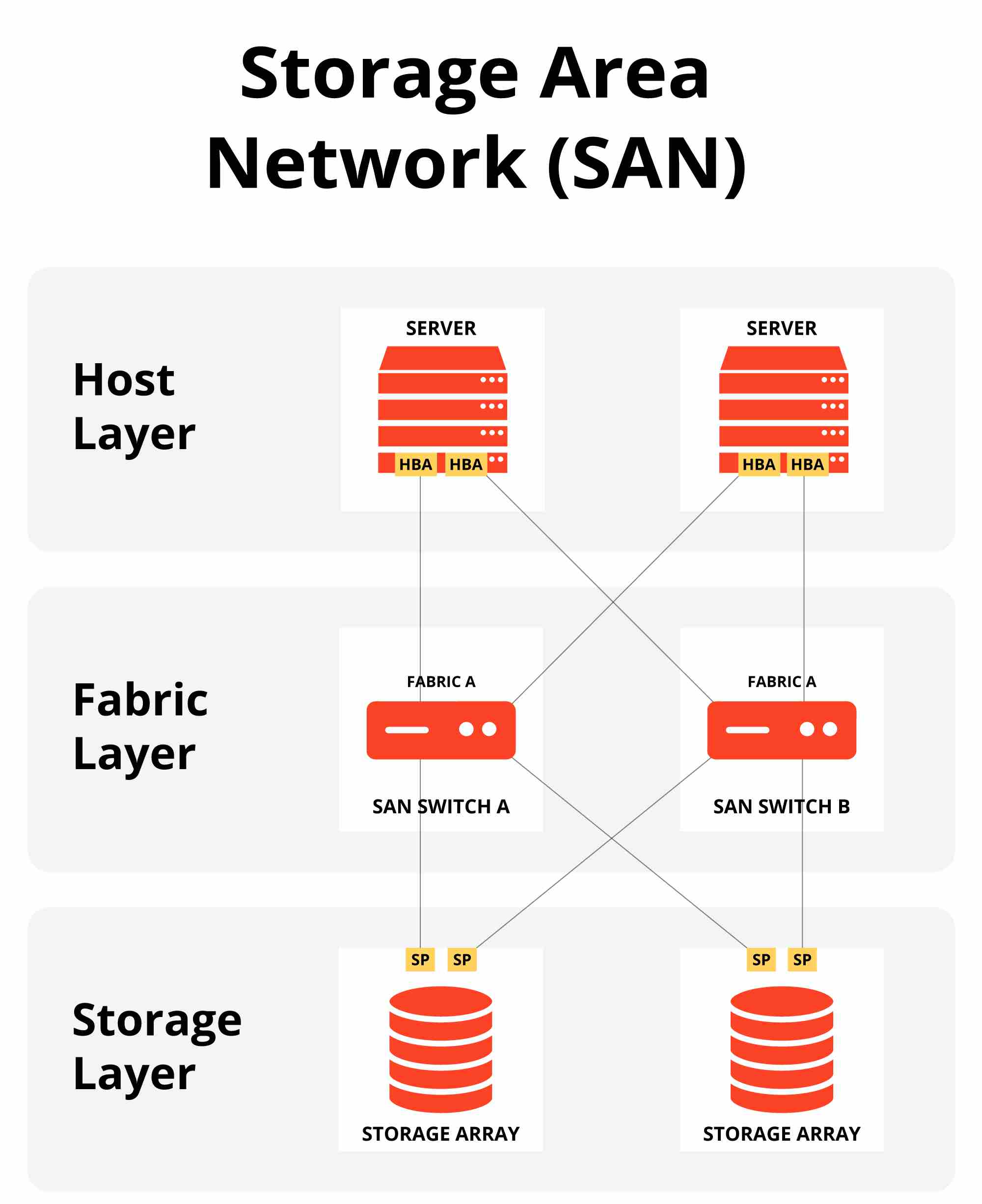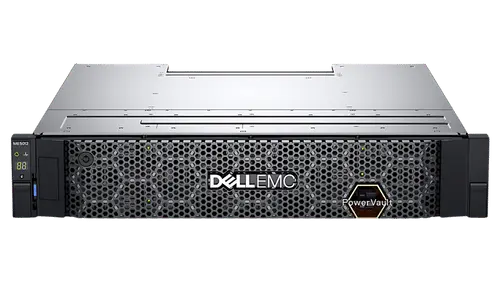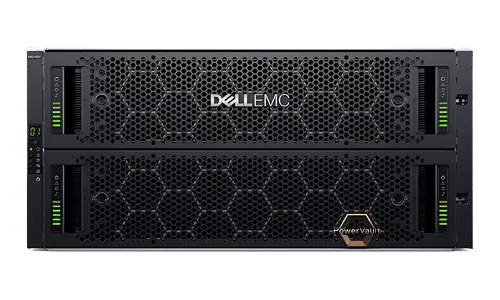A SAN links storage devices such as disk arrays or tape libraries to servers, presenting the storage as locally attached to each server. It utilises high-speed technologies like Fibre Channel, iSCSI, or InfiniBand to enhance data transfer rates and performance. By centralising storage, a SAN enhances data availability, scalability, and management. This configuration is well-suited for environments requiring uninterrupted data access and high data throughput, such as virtualised and cloud computing infrastructures.
How Does a SAN Work
A Storage Area Network creates a separate network that connects storage devices to servers. It uses high-speed protocols and networking tools to allow fast communication between storage and computing resources. When a server needs data, the SAN directs these requests straight to the right storage device, avoiding the general network. This reduces delays and speeds up data transfer. The main parts of a Storage Area Network are:
- Host Bus Adapters (HBAs) in the servers: These connect servers to the Storage Area Network and convert data into signals for the network.
- SAN switches: These manage data traffic and direct it efficiently.
- Storage devices: These store data and can be set up in various RAID configurations.
SANs utilise storage protocols like Fibre Channel, recognised for its speed and reliability, or iSCSI, which transmits SCSI commands over IP networks, beneficial for long-distance connections. These technologies guarantee swift data access and offer backup choices to avert data loss. A storage area network enables high-speed, dependable data transmission by segregating storage traffic from the main network. This configuration is particularly beneficial for applications requiring substantial bandwidth and reliable data availability.

What Are the Advantages of SAN
The advantages of a Storage Area Network are numerous and impactful for any organisation that needs robust and efficient data management.
Improved Performance
SANs use high-speed connectivity technologies and protocols, reducing latency and boosting data transfer rates. It makes them ideal for high-demand applications like databases, virtualisation, and transactional systems.
Increased Data Availability
Centralised storage in a SAN (Storage Area Network) allows for better redundancy and failover mechanisms, ensuring continuous data access even during hardware failures. It enhances business continuity and disaster recovery.

Scalability
For a company’s expanding storage needs, more storage devices can be smoothly added to the existing Storage Area Network, offering flexible expansion.
Simplified Data Management
Centralised storage simplifies administration, backups, and maintenance, reducing time and complexity. It also helps achieve better resource allocation and optimise storage utilisation.
Enhanced Security
Isolating storage traffic from the primary network helps protect sensitive data. Access controls, encryption, and security measures can be managed more easily, reducing the risk of unauthorised access.
Different Types of SAN Solutions
Each Storage Area Network uses protocols to enable communication between software and storage units. Depending on the devices and routers, a Storage Area Network might use one or multiple protocols. There are three main types of SAN solutions:

Fibre Channel
Fibre Channel is a well-established SAN protocol known for its reliability, high performance, and low latency. Ideal for mission-critical applications needing data integrity and fast access times, speeds range from 1 Gbps to 128 Gbps.
iSCSI
iSCSI is a popular SAN protocol that transmits SCSI commands over IP networks. It offers cost-effectiveness and easy integration with existing Ethernet infrastructures, making it suitable for long-distance connections and various business applications.
FCoE (Fibre Channel over Ethernet)
FCoE maps Fibre Channels onto Ethernet networks, allowing SAN traffic to run alongside regular network traffic on the same physical infrastructure.
Each SAN type has its advantages and is suited for specific use cases. Organisations should consider their needs, budget, and existing infrastructure before choosing a SAN solution. A hybrid approach using multiple SAN types might best meet an organisation’s requirements.
When to Use SAN Storage?
Storage Area Network storage is ideal for environments that require high-performing, reliable, and scalable data management. Some common use cases for SAN include:
Databases
Databases often require fast and consistent access to data, making them an optimal use case for SAN storage. With its high-speed connectivity and efficient data transfer rates, a Storage Area Network can help improve database performance and ensure continuous availability.
Virtualisation
As virtualisation technology becomes more prevalent in enterprises, the need for reliable and robust storage solutions is critical. A SAN allows for centralised storage management, making it easier to maintain and scale virtualised environments.
Cloud Computing
Cloud computing relies on efficient data transfer rates and high bandwidth. A Storage Area Network can facilitate these requirements by providing a separate network for storage traffic, reducing latency, and improving overall performance.

Video and Audio production
High-definition video and audio production require large amounts of data storage and fast access to media files. A SAN can offer the speed and capacity needed for these applications, ensuring smooth workflows and minimising downtime.
Causes of SAN Data Loss
While a Storage Area Network can significantly improve data management, there are still potential risks for data loss. Some common causes of SAN data loss include:
- Hardware failures: Like any technology, hardware in a Storage Area Network system can malfunction or fail, leading to data loss.
- Human error: Personnel error, such as accidental deletion or improper configuration, can lead to the loss of critical data on a Storage Area Network.
- Natural disasters: Events like floods, fires, or earthquakes can physically damage the hardware storing data on a Storage Area Network.
- Cyber attacks: Cybercriminals can target and compromise a Storage Area Network, leading to data loss or theft. Strong security is essential for protecting against threats.
Summary
A Storage Area Network (SAN) offers a dedicated network for storage traffic, boosting data performance and availability. With high-speed connectivity, redundancy, scalability, and security, SANs are ideal for databases, virtualisation, cloud computing, and media production. Understanding the different types of SAN solutions helps organisations choose the best one for their storage needs.
Despite its many advantages, Storage Area Network storage can still experience data failure due to hardware failures, software corruption, human error, or cyberattacks. If this happens, it’s crucial to act quickly to reduce the impact. Contact us for expert SAN data recovery services. We specialise in retrieving data from complex Storage Area Network environments using advanced techniques and tools to recover your valuable information and minimise downtime.
Frequently Asked Questions
Is SAN storage a good backup option?
SAN data storage is a good backup option, but there are other solutions. It offers centralised storage and enhanced redundancy, making it viable for backups. However, some organisations also use cloud storage or tape backups alongside SAN. It provides multiple layers of data protection and disaster recovery. The best backup solution depends on an organisation’s specific needs.
What does the SAN stand for?
SAN stands for Storage Area Network. It is a high-speed network that links storage devices to servers, allowing for centralised and efficient data management. SANs use protocols like Fibre Channel or iSCSI to transfer data between the storage devices and servers. They are commonly used in environments with large amounts of data that demand fast and reliable access, such as databases, virtualisation, and cloud computing.
What is the difference between SAN and NAS?
The primary difference between a Storage Area Network and NAS (Network-Attached Storage) is in their architecture and usage.
- SANs are high-speed networks that provide block-level storage and allow direct access to storage devices. They are ideal for applications needing fast and reliable data access, such as databases and virtualisation.
- NAS operates at the file level, making it suitable for file sharing and collaborative work. It is often used for user-friendly file storage and easy data sharing across networks.
Does SAN use SSD?
Yes, SANs can use SSD (Solid-State Drives) and HDD (Hard Disk Drives) storage devices. The type of storage device used depends on the organisation’s needs and budget. SSDs offer faster data access speeds but are more expensive than HDDs.
What is SAN Drive?
A SAN drive is a storage device that is connected to a Storage Area Network. It allows for centralised storage and data access, providing high performance and scalability. SAN drives can be either HDD or SSD, depending on the organisation’s needs and budget. They are commonly used in environments with large amounts of data, such as databases, virtualisation, and cloud computing.


